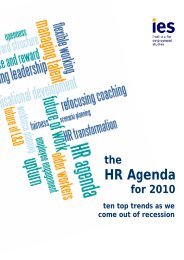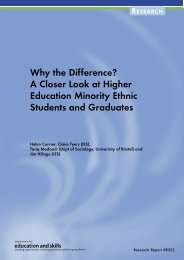Post-16 Transitions: a Longitudinal Study of Young People with ...
Post-16 Transitions: a Longitudinal Study of Young People with ...
Post-16 Transitions: a Longitudinal Study of Young People with ...
You also want an ePaper? Increase the reach of your titles
YUMPU automatically turns print PDFs into web optimized ePapers that Google loves.
Table 5.25: Parent/carer view on extent to which young person’s activities since Year 11<br />
have followed the transition plan<br />
All<br />
State–<br />
mented<br />
Not state–<br />
mented<br />
Special<br />
school<br />
Mainstream<br />
school<br />
N = % % % % %<br />
A great deal 280 30 33 26 34 28<br />
A fair amount 313 33 37 24 39 29<br />
Not very much 117 13 13 15 11 15<br />
Not at all 111 14 11 22 8 17<br />
Didn’t know what the plans were 73 9 7 14 8 10<br />
N = 894 746 131 399 495<br />
Note: All percentages are weighted percentages, unless otherwise stated<br />
Source: IES/MORI 2003<br />
In line <strong>with</strong> young people’s views, most parents thought that<br />
the reason their post-<strong>16</strong> activities had not followed the<br />
transition plan was because the young person had decided to<br />
do something else (Table 5.27). Parents were also likely to<br />
mention ill-health and a lack <strong>of</strong> necessary qualifications as<br />
barriers to conforming to the transition plan. However, more<br />
than ten per cent <strong>of</strong> parents reported that it was the lack <strong>of</strong><br />
help, support or follow-up that prevented the young person<br />
from achieving the aims <strong>of</strong> the transition plan. Interestingly,<br />
though, ten per cent <strong>of</strong> parents also said that the young person<br />
had not followed the transition plan because the parent or<br />
carer wanted them to follow a different course <strong>of</strong> action. Just<br />
six per cent <strong>of</strong> parents thought the plan had been unrealistic.<br />
Table 5.26: Parent/carer view on extent to which young person’s activities since Year 11<br />
have followed the transition plan, by SEN (per cent)<br />
Communi–<br />
cation and<br />
Interaction<br />
Cognition<br />
and<br />
learning<br />
Sensory<br />
and/or<br />
physical<br />
Behaviour/<br />
emotional/social<br />
development<br />
A great deal 30 30 43 25<br />
A fair amount 37 32 39 30<br />
Not very much 11 14 10 18<br />
Not at all 14 15 3 15<br />
Didn’t know what the plans were 8 10 6 11<br />
N = 224 480 75 115<br />
Note: All percentages are weighted percentages, unless otherwise stated<br />
Source: IES/MORI 2003<br />
<strong>Post</strong>-<strong>16</strong> <strong>Transitions</strong> <strong>of</strong> <strong>Young</strong> <strong>People</strong> <strong>with</strong> SEN: Wave 2 87

















